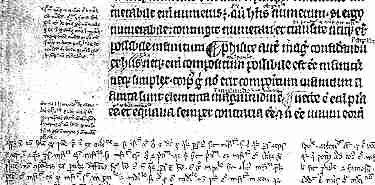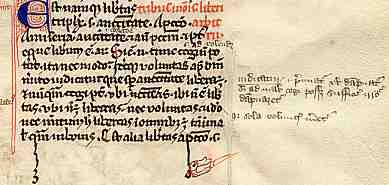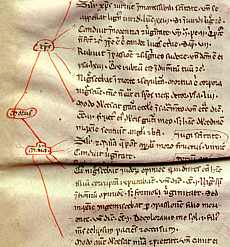




If you are looking at this page without frames, there is more information about medieval writing to be found by going to the home page (framed) or the site map (no frames).
| Religious Instruction and Commentary (2) | ||||
| These learned texts were always densely written, with no concessions for those whose literacy was not up to an acceptable standard. These were works for study. | ||||
 |
This is a sample from the writings of St Hilarius of Poitiers, dating from 509-10 AD (Rome, Archivio di S. Pietro, D.182. (From Steffens 1929) | |||
| The above example, a complex work on the nature of the Holy Trinity, is written, like many such works of this early date, in continuous writing without word breaks. The script is half uncial. The very process of reading such writing was arduous, let alone understanding it properly. | ||||
 |
The introduction of glossed texts, as in this Biblical example, not only made each page even more densely written, but reading was no longer a simple linear process. Spaces were left on the page for chunks of commentary, while individual sentences or even words, were selected out for discussion in the interlinear gloss. The Biblical gloss was a standard text, assembled from the works of various patristic authors and copied along with the main text when the work was transcribed. This was not the Bible for reading in church, but the Bible for attentive study. | |||
| Glossed copy of the Book of Leviticus and the Gospel of St John, from St Mary's Abbey, Buildwas in 1176, now in the British Library. (From M.R. James 1925 Abbeys London: The Great Western Railway) | ||||
| The learned added their own commentary to the works of others from the past, effectively forming composite texts which ran in parallel. | ||||
 |
A 13th century work of Aristotle's Physica surrounded by a gloss of St Thomas Aquinas (Vatican Library, Urbin. 206, f.306). (From Ehrle and Libaert 1932) | |||
| In the above example, the formal Gothic textura of the main text contrasts with the tiny, simplified and heavily abbreviated text of the gloss. The resurrection of pagan Classical authors for incorporation into Christian moral philosophy was heavy literary work. Similar processes occurred as medieval authors built on the works of each other. | ||||
 |
Sample from a 14th century copy of the Sententiae of Peter Lombard, with a contemporary gloss, from a private collection. | |||
| The above example represents a 14th century copy of a 12th century work, produced with very elegant calligraphy in a small but elegant Gothic book hand, and glossed in an approximately contemporary hand in a cursive script. The glosses are extensive, and the book was evidently written with very wide page margins for the purpose. The strange little graphic at the bottom, which looks like the head of a dog with a pointer in its mouth, is presumably intended to emphasis some particularly salient point. | ||||
 |
The tiny and abbreviated glossing script could be used for a whole work if it was designed for study rather than reading aloud in public. The example at left shows some of the reading apparatus of such a text, which contains assorted marginalia to link bits of text together or point out particular sections. This also indicates a style of reading which is not strictly linear, and involves much fossicking around the very tightly written text. | |||
| Segment from a page of a work by Albertus Magnus, or alternatively by Richardus de Sancto Laurentio, in praise of the Virgin Mary, from a private collection. | ||||
| If you think about these examples, they indicate that religious instruction and commentary was not simply handed down through generations to be learned and repeated. This was an area that was constantly under development and refinement by those members of the clergy with the most scholarly reading skills. The page layout and reading guides are complex, the scripts are tiny and abbreviated, and any work, new or old, can be examined and commented on in the most minute of detail. | ||||
If you are looking at this page without frames, there is more information about medieval writing to be found by going to the home page (framed) or the site map (no frames). |
||||